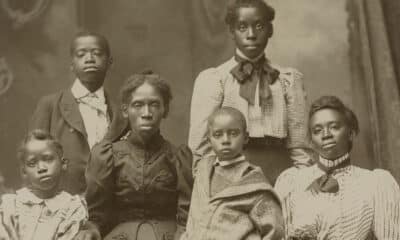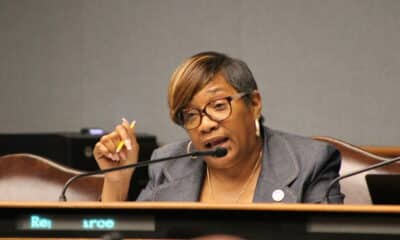Kaiser Health News
Harris, Once Biden’s Voice on Abortion, Would Take an Outspoken Approach to Health
Stephanie Armour and Julie Appleby, KFF Health News and Julie Rovner, KFF Health News
Sun, 21 Jul 2024 21:30:00 +0000
Throughout Joe Biden’s presidency, he leaned on the outspoken former prosecutor and senator he selected as his vice president, Kamala Harris, to be the White House’s voice of unflinching support for reproductive health rights.
Now, as Democrats rebuild their presidential ticket just a few months before Election Day, Harris would widely be expected to take an aggressive stance in support of abortion access if she became the party’s new presumptive nominee — hitting former President Donald Trump on an issue that could undermine his chances of victory. Biden endorsed Harris on Sunday when he announced his decision to leave the race.
While Biden sought to keep abortion center stage in his reelection bid, abortion advocates had harbored doubts that the president — a practicing Catholic who has said he is not “big on abortion” — could be an effective standard-bearer as Republican efforts erode access to abortion and other women’s health care around the country.
Harris, on the other hand, became the first vice president to visit a clinic run by the Planned Parenthood Federation of America. She undertook a nationwide tour focused on reproductive rights. And when Sen. JD Vance of Ohio was named Trump’s running mate, Harris used her next campaign appearance to criticize him for blocking protections for in vitro fertilization.
“Most significantly, Harris would be the face of the drive to protect abortion rights,” Larry Levitt, executive vice president for health policy at KFF, a health information nonprofit that includes KFF Health News, said in an interview before Biden stepped aside. “Abortion access would likely be front and center in her campaign.”
A strong stance on abortion is not the only major contrast to the GOP that Harris offers: She is well versed in health policy. As a child, Harris often accompanied her mother to work on the weekends, visiting the lab where she was studying breast cancer.
While running for president in 2019, she backed “Medicare for All,” a single-payer insurance proposal that established her bona fides as a more progressive voice on health policy. And as California’s attorney general, she fought against consolidation in the health industry over concerns it would drive up prices.
She stumped for a Biden administration rule setting minimum staffing levels at federally funded nursing homes in April.
“She deserves credit, she’s talked about them on the campaign trail. I don’t see any change there in the priorities on what Democrats want to do on health care if she becomes the nominee,” said Debbie Curtis, vice president at McDermott + Consulting.
An intensified focus on women’s health and abortion could help galvanize Democratic voters in the final sprint to the election. Since the three Supreme Court justices named by Trump helped overturn Roe v. Wade in 2022, public opinion has turned against Republicans on abortion, even contributing to an unexpectedly poor showing in the 2022 midterm elections.
Thirty-two percent of voters said they would vote only for a candidate for a major office who shares their views on abortion, according to a Gallup Poll conducted in May. That’s a record high since Gallup first asked the question in 1992. Nearly twice as many voters who support abortion, compared with those who oppose abortion, hold that view.
Sixty-three percent of adults said abortion should be legal in all or most cases, based on a poll conducted in April by Pew Research Center. Thirty-six percent said it should be illegal in all or most cases.
Republicans, in turn, have been eager to distance themselves from their own victory on the issue. Trump angered some members of his base by saying he would leave decisions on abortion to the states.
Regardless, advocates caution that the GOP’s new moderation-by-omission on the issue masks their actual, more extreme stance. Vance has been clear in the past about his support for a national abortion ban. And while the GOP platform adopted during the party’s convention last week may not explicitly call for a nationwide ban on abortion, party leaders’ recognition of “fetal personhood,” the idea that as soon as an egg is fertilized it becomes a person with full legal rights, would create such a ban automatically if the Supreme Court found it constitutional.
Those views stand in contrast to those of many Republicans, especially women. About half of Republican women voters think abortion should be legal in all or most cases, according to a recent national survey by KFF. And majorities of women who vote Republican believe abortion should be legal in cases of rape, incest, or a pregnancy emergency.
If Harris heads the ticket, she would be expected to hammer on those issues in the coming months.
“It’s been one of if not the main issue she’s emphasized in the last year or two,” said Matthew Baum, Marvin Kalb professor of global communications at Harvard University. “Clearly the Republicans are trying to defang the issue. It’s been a disaster for them.”
It is likely, though, that Republicans would paint Harris’ views on abortion as extremist. During the presidential debate against Biden, Trump falsely claimed Democrats support abortions late in pregnancy, “even after birth.”
Shortly after news broke that Biden had endorsed Harris, Susan B. Anthony Pro-Life America issued a statement calling out Harris’ record and offering evidence of what is to come. “While Joe Biden has trouble saying the word abortion, Kamala Harris shouts it,” said Marjorie Dannenfelser, the group’s president.
Some pollsters have said Harris would have to do more than just campaign against Republican efforts to roll back abortion access to truly motivate voters because so many issues, such as inflation, the economy, and immigration, are competing for attention.
“She has to say she is running for a federal law that will bring back Roe v. Wade,” said Robert Blendon, an emeritus public health professor at Harvard University. “She needs something very specific and clear.”
Harris’ elevation to the top of the ticket would come at a critical juncture in the fight over reproductive rights.
The Supreme Court heard two abortion cases in the term that ended this month. But the justices did not address the merits of the issues in either case, ruling instead on technicalities. Both are expected to return to the high court as soon as next year.
In one case, challenging the FDA’s 2000 approval of the abortion pill mifepristone, the justices ruled that the group of anti-abortion medical professionals who challenged the drug lacked standing to sue because they failed to show they were personally injured by its availability.
But the Supreme Court returned the case to the district court in Texas where it was filed, and the GOP attorneys general of three states — Idaho, Kansas, and Missouri — have joined the case as plaintiffs. Whether the courts accept the states as viable challengers remains to be seen, but if they do, the justices could soon be asked again to determine the fate of the abortion pill.
The other abortion-related case pitted a federal law requiring hospitals to provide emergency care against Idaho’s strict ban, which allows abortions when a pregnant patient’s life is in danger — but not in cases in which it is necessary to protect her health, including future fertility.
In that case, the justices apparently failed to reach any majority agreement, declaring instead that they were premature in accepting the case and sending it back to the lower court for further consideration. That case, too, could return in relatively short order.
Harris would also have substantial leeway to talk about what are considered to be the Biden administration’s core health policy accomplishments. These include enhanced Affordable Care Act tax credits aimed at helping consumers get health insurance coverage, which were extended through the Inflation Reduction Act into 2025, the $35 monthly cap on copays some patients pay for insulin, and drug price negotiation in Medicare.
“I think she is well positioned. She is core to the administration and will be able to take credit for those things,” said Dan Mendelson, CEO of Morgan Health, a subsidiary of J.P. Morgan Chase.
That said, it may be hard for any candidate to get voters to focus on some of those accomplishments, especially drug price efforts.
While the administration has taken some important steps, “new expensive drugs keep coming out,” Mendelson said. “So if you look at the perception of consumers, they do not believe the cost of drugs is going down.”
Joseph Antos, of the American Enterprise Institute, said Harris would likely say the Biden-Harris administration “is already saving people money” on insulin. But she will have to go beyond these accomplishments and double down on drug pricing and other cost issues — not talk solely about reproductive rights.
“She’s got to concentrate, if she wants to win, on issues that have a broad appeal,” Antos said. “Cost is one and access to treatments is another big issue.”
Samantha Young of KFF Health News contributed to this report.
——————————
By: Stephanie Armour and Julie Appleby, KFF Health News and Julie Rovner, KFF Health News
Title: Harris, Once Biden’s Voice on Abortion, Would Take an Outspoken Approach to Health
Sourced From: kffhealthnews.org/news/article/kamala-harris-health-agenda-abortion-womens-health-2024-election/
Published Date: Sun, 21 Jul 2024 21:30:00 +0000
Kaiser Health News
Texas Measles Outbreak Nears 100 Cases, Raising Concerns About Undetected Spread
SUMMARY: A measles outbreak in West Texas has led to private school closures, overwhelming local health departments. Since the outbreak began three weeks ago, 90 cases have been confirmed, mostly in children under 18, with 16 hospitalizations. Health officials fear the outbreak will worsen, and some parents may be avoiding testing their children. The outbreak has been exacerbated by low vaccination rates, particularly in communities like Gaines, which has one of the lowest vaccination rates in Texas. Local officials are working to contain the virus through pop-up clinics, mobile testing, and educating schools, but the situation remains challenging.
The post Texas Measles Outbreak Nears 100 Cases, Raising Concerns About Undetected Spread appeared first on kffhealthnews.org
Kaiser Health News
GOP Takes Aim at Medicaid, Putting Enrollees and Providers at Risk
SUMMARY: Republicans are again targeting Medicaid, proposing significant funding cuts to finance President Trump’s agenda on tax cuts and border security. Approximately 79 million people rely on Medicaid and the Children’s Health Insurance Program (CHIP), vital for numerous hospitals and states. Amid Democratic resistance, potential cuts could include reducing federal matching funds and imposing work requirements, which critics argue adds unnecessary barriers. Historically controversial, these efforts reflect deep partisan divides over Medicaid’s role as a safety net versus a welfare program. Many Americans favor Medicaid, making proposed cuts politically sensitive. The outcome remains uncertain as GOP leaders face internal challenges.
The post GOP Takes Aim at Medicaid, Putting Enrollees and Providers at Risk appeared first on kffhealthnews.org
Kaiser Health News
An Ice Rink To Fight Opioid Crisis: Drug-Free Fun vs. Misuse of Settlement Cash
SUMMARY: Carter County, Kentucky, has controversially spent $15,000 of its opioid settlement funds on an ice rink, raising concerns about its relevance to the ongoing opioid crisis. Advocates argue that resources could be better allocated to overdose prevention, such as Narcan kits or local substance abuse programs. Brittany Herrington, a local in recovery, criticized the decision as neglecting community needs. While officials claim the rink fosters drug-free youth activities, critics note it lacks direct ties to combating addiction. Local leaders are calling for stricter oversight on how settlement funds are used, emphasizing the need for targeted support in addressing substance use disorders.
The post An Ice Rink To Fight Opioid Crisis: Drug-Free Fun vs. Misuse of Settlement Cash appeared first on kffhealthnews.org
-

 News from the South - Louisiana News Feed2 days ago
News from the South - Louisiana News Feed2 days agoJeff Landry’s budget includes cuts to Louisiana’s domestic violence shelter funding
-

 News from the South - North Carolina News Feed6 days ago
News from the South - North Carolina News Feed6 days agoModest drops in some North Carolina prices under Trump | North Carolina
-

 News from the South - North Carolina News Feed2 days ago
News from the South - North Carolina News Feed2 days agoBills from NC lawmakers expand gun rights, limit cellphone use
-

 News from the South - Arkansas News Feed6 days ago
News from the South - Arkansas News Feed6 days agoTiming out the incoming winter weather
-

 News from the South - Oklahoma News Feed5 days ago
News from the South - Oklahoma News Feed5 days agoRemains of Aubrey Dameron found, family gathers in her honor
-

 News from the South - Kentucky News Feed7 days ago
News from the South - Kentucky News Feed7 days agoEight die in flooding across Kentucky as rescues continue, governor warns of ‘wild weather week’
-

 News from the South - Florida News Feed6 days ago
News from the South - Florida News Feed6 days agoExpert discusses how deportations could cause labor shortages for several industries
-

 News from the South - Florida News Feed5 days ago
News from the South - Florida News Feed5 days agoTrump says AP will continue to be curtailed at White House until it changes style to Gulf of America










































